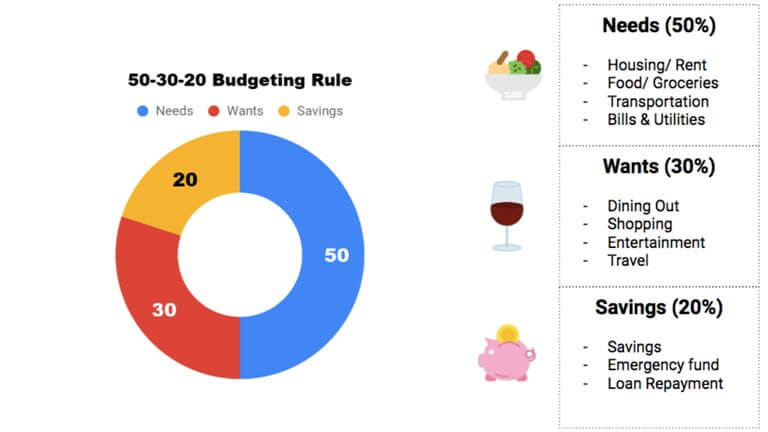Nothing can beat the happiness when we receive our paycheck, and right before we received it, we plan for many things to buy, how to use it, and so on. Everyone can relate this feeling, right! But we may also fear of last dates of the month. Why do we end-up with less amount at the end of every month? This is because of not planning the right budget that goes well with you. Improper budget can put you in debts. So it is better to have the best budget by considering all the factors and assigning them into a proper category.
In today’s world, many come with their budget ideas but among all those budget plans, the 50/30/20 rule is famous. Why is it very famous? What is the 50/30/20 rule? So to know the answers and to have a proper conclusion on how to plan a budget, let us check them in detail in this article.
What Is The 50/20/30 Rule?
In this article
Senator Elizabeth Warren was popularized by the 50/30/20 rule, published in her book called “All Your Worth: The Ultimate Life Time Money Plan.” According to the 50/30/20 rule, a person should spend his 50% of after-tax income on needs and 30% of after-tax income on expenses that make you comfortable and the remaining 20% of after-tax income for savings.
But what is the so-called “after-tax income”? Generally, after-tax income is the total income excluding the tax money, i.e., it represents income remained after paying all your required taxes.
This 50/30/20 rule is very simple and easy to understand. This doesn’t have any complex structure to misguide you, and also it categories needs, expenses, etc. in a perfect manner. So let us discuss each rule in detail.

50% Rule: Needs
Needs are those which are to be covered to survive in this world. So it is better to make 50% of your after-tax income for needs.
The things that are included in the needs category are:
i.Premiums that you have to pay for your insurance plans.
ii. Rents, if any, mortgage payments, groceries, minimum debt payments, utilities, etc.
iii. Fees for your children and also money for some educational purposes etc.
This doesn’t include extras like subscriptions for Netflix, Amazon, dining out with your family and friends, etc.
Half of your after-tax payments are necessary for these needs; if 50 is not sufficient to cover necessities, then try to cut down unnecessary expenses like subscriptions and also prefer to take public transportations if possible. We always have to maintain a proper money schedule or-else things may go wrong.
30% Rule: Wants
This category contains things that are not particularly essential for human beings to survive. These can be simply categorized into an entertainment zone. So make sure that you divide things into need and expenses perfectly. Things that are included in the 30% rule are;
- Dining out with your family and friends.
- Watching a movie, buying a handbag, etc. Buying clothes is essential, so it doesn’t include in wants.
- Planning a vacation trip, buying tickets for sports events and more fun events.
- Planning to buy the latest electronic gadgets and ultra-speed internet etc.
Sometimes buying costlier things rather than buying them in fewer payments are also included in the wants list.
If you want to save more money for your future needs, then you can cut down some of your wants because, as I have already said these items are just for entertainment and not particularly your needs. If you cut-down want as much as you can, you can save money for your future needs.
20% Rule: Savings
This is an essential part to make because we don’t know what happens in the future. So it is better to start saving when things are right. So every month, make sure that you save 20% of your after-tax income for savings.
Every household must think about emergencies that may occur in the future and try to save their income as much as possible. If your savings exceed the minimum account required, then you can plan for investing them in mutual funds, which give higher returns.
So, I am saying that there are no losses if you save your income for emergency funds.Savings can include investing in stocks and mutual funds, saving in as emergency funds, etc.
As we have understood what is 50/30/20 rule, we need to understand how we can distribute money monthly as per this rule.
How To Make A Realistic Budget Plan?
So make sure that you plan a realistic budget for a proper money plan. What is a realistic budget plan? Well, if you end-up scheduling a very tight budget plan, then you wish not to follow it, and you intentionally stop to follow that budget because things are very un-comfort for you. Also, if you plan for a very lenient budget plan, then you may take it easy, and there are high chances that you may feel overconfident and leave the schedule. So make sure that you plan accordingly that you can live comfortably with a good financial background.
To build a proper budget plan you have to know the right answers for the following questions;
1. What is my total monthly income?
2. What are my must-haves?
3. What are my Wants?
4. Am I paying my loans too fast?
So, let us discuss what answers can you get for the above questions in detail.
What Is My Total Monthly Income?
Here when you budget plan you should consider the money that is credited in your bank account every month and not your gross income.
For salaried individuals, the salary credited in the bank’s account is the net of taxes and net contributions towards their retirement savings. So there is a slight difference in the gross income and income that is credited into your bank. For a budget plan you should include taxes that are applied to your income and the remaining is considered for budgeting.
For self-employed individuals, the total income includes all their earning minus tax liabilities. For self-employed people, there are additional taxes like business tax and tax for his office tec. So it becomes difficult to save much for them. But this 50/30/20 rule is very simple and effective so don’t lose hope.
If any family member like your spouse is also an employee or an earning member, then you can include their income for your monthly budget plan only if they wish to.
Once you clearly distinguish what is what, then you can go to the next question.
What Are My Must-Haves?
Must-have are necessities which if not followed or considered seriously may affect your lifestyle. Necessities include things like rents, fees for children, premiums for your insurance plans and all other things that come for food, clothing, and shelter.
Note down all your family needs because different households will have different needs and we can’t categorize in particular. So, it is better to write down all your family needs and their costs and make sure that the sum of all the needs is less than 50% of your after-tax income.
If it is more than 50% then cut-down a little or else cut-down your wants and add them to your needs. Once you have done this go for next question.
What Are My Wants?
Wants are nothing but things that come into the entertainment zone of a family. This includes dining out, having a field trip, fun etc. these include expenses linked with our standard of living. It is sure that every person will have additional expenses such as car repairs, bike repairs etc. After listing out needs, make a list of your wants that you wish to have and write down their costs.
Later ensure that sum of your wants should not exceed 30% of your after-tax income or else cut-down your wants list.
Later the last thing that you have to check while planning a budget is:
Am I Paying Loans Too Fast?
It is good to save money for future purposes so make sure that you save much as possible that it covers expenses up to the next 6 months.
After writing down all the costs that include needs and wants items and calculate how much money is remained with you. It should be 20% of your after-tax income. Try to allocate more funds for your savings or else invest some of your savings in mutual funds, which gives you higher returns.
So after listing out all the things that you require, you will get a clear view about your budget and what additional changes should be done.
Understand the 50/30/20 Rule With An Example
Let’s say that your after-tax income every month consists of Rs.1, 50,000. So according to the 50/30/20 rule, you can have 50% of your income for needs i.e. Rs.75, 000 can be used for your needs.
You can spend your Rs.75, 000 for all your rents, payments. Later remaining amount can be used for further savings. If you wish to buy things according to your living standards, then use 30% of your income, i.e. Rs.45, 000. Make sure that it doesn’t exceed 30% of your total income. Later save the remaining 20%, i.e., Rs.30,000 for emergency funds.
You can use some amount of your Rs.30, 000 for mutual funds too. You can use these savings to cover expenses for house building, car, or vacation. Like this, try to save your money and live comfortably.
Different Budget Options
There are many budget options in the world which can help you.
Let us look into some of the other budget options.
a. Zero-Sum
The principle behind this is to allocate each penny of your income to specific expenses so that you know how much you have paid and on what. With this data, you can minimize the additional expenses and have a safe and sound life.
b. Envelope Budgeting
Without using your credit card, use envelopes instead. Like put some pre-determined money in envelopes and use them instead of swiping your card. This ensures that you know how much you have put in the envelope to buy things of that price. It makes you reduce your higher standards of living.
Final Talk
Prepare your own excel sheet to plan a budget. This helps you to track your expenses and so you can cut-down. It is very easy and simple, and it suits all most every individual. This is just my opinion, and you can try any budget plan that suits you well. Try to cut down your expenses and work on saving them for the future. This planning takes only half a day and best of luck for your budget planning. Just remember The 50/30/20 rule.


Leave a Reply